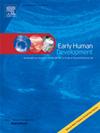Comparison of 2D:4D digit ratios in patients with Hashimoto's and Graves' diseases: A systematic review
IF 2
3区 医学
Q2 OBSTETRICS & GYNECOLOGY
引用次数: 0
Abstract
This systematic review includes three descriptive studies that investigated the relationship between biological markers such as the 2D:4D digit ratio and morphological femininity and thyroid diseases. Two of the studies involved only female participants, while one included both males and females. Participants ranged in age from 20 to 80, and all studies applied inclusion criteria such as being of the same ethnic origin and having no history of hand or finger injuries. The studies suggest that autoimmune thyroid disorders like Hashimotos thyroiditis and Graves' disease may be associated with prenatal exposure to sex hormones. A higher 2D:4D ratio is considered indicative of greater prenatal estrogen exposure, whereas a lower ratio reflects higher testosterone exposure. Individuals with Hashimoto's thyroiditis were found to have significantly higher 2D:4D ratios compared to healthy controls, while those with Graves' disease had lower ratios. Differences in the right-hand 2D:4D ratio were more pronounced than those in the left hand. One study also found a positive correlation between morphological femininity and the severity of Hashimoto's disease, as measured by TPOAb levels. These findings indicate that hormonal influences during prenatal and adolescent periods may have lasting effects on the immune system and thyroid function. However, all studies included in this review are descriptive in nature, and thus, the results are correlational rather than causal. Further prospective studies and systematic reviews are needed to better understand these associations.
桥本病和格雷夫斯病患者2D:4D手指比例的比较:一项系统综述
本系统综述包括三个描述性研究,探讨了2D:4D手指比例等生物标志物与形态学女性化和甲状腺疾病之间的关系。其中两项研究只涉及女性参与者,而另一项研究包括男性和女性。参与者的年龄从20岁到80岁不等,所有的研究都采用了相同的种族起源和没有手部或手指受伤史等纳入标准。研究表明,自身免疫性甲状腺疾病,如桥本甲状腺炎和格雷夫斯病,可能与产前暴露于性激素有关。较高的2D:4D比值被认为表明产前雌激素暴露较多,而较低的比例则表明睾酮暴露较高。与健康对照相比,桥本甲状腺炎患者的2D:4D比值明显较高,而格雷夫斯病患者的2D:4D比值较低。右手2D:4D比例的差异比左手更明显。一项研究还发现,形态女性化与桥本氏病的严重程度之间存在正相关,这是通过TPOAb水平来测量的。这些发现表明,产前和青春期的荷尔蒙影响可能对免疫系统和甲状腺功能有持久的影响。然而,本综述中包含的所有研究本质上都是描述性的,因此,结果是相关的,而不是因果关系。需要进一步的前瞻性研究和系统评价来更好地了解这些关联。
本文章由计算机程序翻译,如有差异,请以英文原文为准。
求助全文
约1分钟内获得全文
求助全文
来源期刊

Early human development
医学-妇产科学
CiteScore
4.40
自引率
4.00%
发文量
100
审稿时长
46 days
期刊介绍:
Established as an authoritative, highly cited voice on early human development, Early Human Development provides a unique opportunity for researchers and clinicians to bridge the communication gap between disciplines. Creating a forum for the productive exchange of ideas concerning early human growth and development, the journal publishes original research and clinical papers with particular emphasis on the continuum between fetal life and the perinatal period; aspects of postnatal growth influenced by early events; and the safeguarding of the quality of human survival.
The first comprehensive and interdisciplinary journal in this area of growing importance, Early Human Development offers pertinent contributions to the following subject areas:
Fetology; perinatology; pediatrics; growth and development; obstetrics; reproduction and fertility; epidemiology; behavioural sciences; nutrition and metabolism; teratology; neurology; brain biology; developmental psychology and screening.
 求助内容:
求助内容: 应助结果提醒方式:
应助结果提醒方式:


